Black & Decker LDX116, LDX120 User Manual
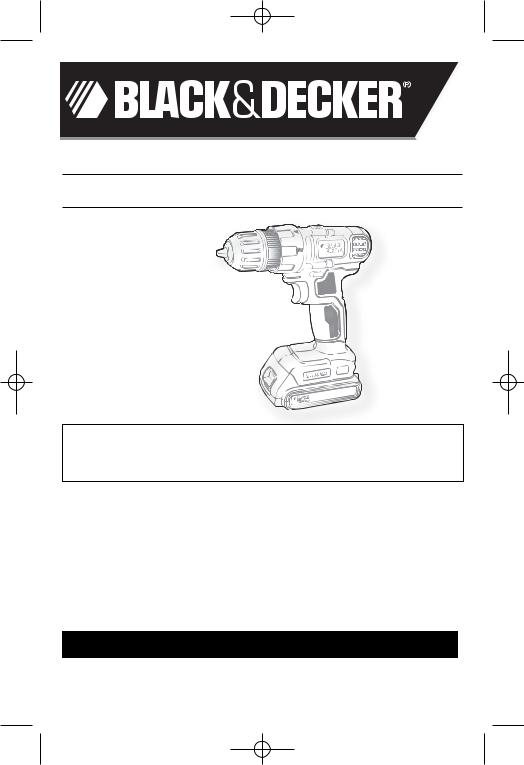
90565379 LDX116 LDX120.qxd:??????-00 BDL500 laser 6/3/10 1:43 PM Page 1
16V & 20V MAX* CORDLESS DRILLS
INSTRUCTION MANUAL
Catalog Numbers
LDX116 (16V MAX*)
LDX120 (20V MAX*)
*Maximum initial battery pack voltage (measured without a workload) is 16 volts. Measured under a workload, nominal voltage is 14.4.
*Maximum initial battery pack voltage (measured without a workload) is 20 volts. Measured under a workload, nominal voltage is 18.
Thank you for choosing Black & Decker! Go to www.BlackandDecker.com/NewOwner to register your new product.
PLEASE READ BEFORE RETURNING THIS
PRODUCT FOR ANY REASON:
If you have a question or experience a problem with your Black & Decker purchase, go to
HTTP://WWW.BLACKANDDECKER.COM/INSTANTANSWERS for instant answers 24 hours a day.
If you canʼt find the answer or do not have access to the internet,
call 1-800-544-6986 from 8 a.m. to 5 p.m. EST Mon. -- Fri. to speak with an agent. Please have the catalog number available when you call.
SAVE THIS INSTRUCTION MANUAL FOR FUTURE REFERENCE.
VEA EL ESPAÑOL EN LA CONTRAPORTADA.
INSTRUCTIVO DE OPERACIÓN, CENTROS DE SERVICIO Y PÓLIZA DE GARANTÍA. ADVERTENCIA: LÉASE ESTE INSTRUCTIVO ANTES DE USAR EL PRODUCTO.

90565379 LDX116 LDX120.qxd:??????-00 BDL500 laser 6/3/10 1:43 PM Page 2
General Power Tool Safety Warnings
 WARNING! Read all safety warnings and instructions. Failure to follow the warnings and instructions may result in electric shock, fire and/or serious injury.
WARNING! Read all safety warnings and instructions. Failure to follow the warnings and instructions may result in electric shock, fire and/or serious injury.
Save all warnings and instructions for future reference.
The term “power tool” in the warnings refers to your mains-operated (corded) power tool or battery-operated (cordless) power tool.
1)Work area safety
a)Keep work area clean and well lit. Cluttered or dark areas invite accidents.
b)Do not operate power tools in explosive atmospheres, such as in the presence of flammable liquids, gases or dust. Power tools create sparks which may ignite the dust or fumes.
c)Keep children and bystanders away while operating a power tool. Distractions can cause you to lose control.
2)Electrical safety
a)Power tool plugs must match the outlet. Never modify the plug in any way. Do not use any adapter plugs with earthed (grounded) power tools. Unmodified plugs and matching outlets will reduce risk of electric shock.
b)Avoid body contact with earthed or grounded surfaces such as pipes, radiators, ranges and refrigerators. There is an increased risk of electric shock if your body is earthed or grounded.
c)Do not expose power tools to rain or wet conditions. Water entering a power tool will increase the risk of electric shock.
d)Do not abuse the cord. Never use the cord for carrying, pulling or unplugging the power tool. Keep cord away from heat, oil, sharp edges or moving parts.
Damaged or entangled cords increase the risk of electric shock.
e)When operating a power tool outdoors, use an extension cord suitable for outdoor use. Use of a cord suitable for outdoor use reduces the risk of electric shock.
f)If operating a power tool in a damp location is unavoidable, use a ground fault circuit interrupter (GFCI) protected supply. Use of a GFCI reduces the risk of electric shock.
3)Personal safety
a)Stay alert, watch what you are doing and use common sense when operating a power tool. Do not use a power tool while you are tired or under the influence of drugs, alcohol or medication. A moment of inattention while operating power tools may result in serious personal injury.
b)Use personal protective equipment. Always wear eye protection. Protective equipment such as dust mask, non-skid safety shoes, hard hat, or hearing protection used for appropriate conditions will reduce personal injuries.
c)Prevent unintentional starting. Ensure the switch is in the off-position before connecting to power source and/or battery pack, picking up or carrying the tool. Carrying power tools with your finger on the switch or energizing power tools that have the switch on invites accidents.
d)Remove any adjusting key or wrench before turning the power tool on. A wrench or a key left attached to a rotating part of the power tool may result in personal injury.
e)Do not overreach. Keep proper footing and balance at all times. This enables better control of the power tool in unexpected situations.
f)Dress properly. Do not wear loose clothing or jewellery. Keep your hair, clothing and gloves away from moving parts. Loose clothes, jewellery or long hair can be caught in moving parts.
g)If devices are provided for the connection of dust extraction and collection facilities, ensure these are connected and properly used. Use of dust collection can reduce dust-related hazards.
4)Power tool use and care
a)Do not force the power tool. Use the correct power tool for your application.
The correct power tool will do the job better and safer at the rate for which it was designed.
2
b)Do not use the power tool if the switch does not turn it on and off. Any power tool that cannot be controlled with the switch is dangerous and must be repaired.
c)Disconnect the plug from the power source and/or the battery pack from the power tool before making any adjustments, changing accessories, or storing power tools. Such preventive safety measures reduce the risk of starting the power tool accidentally.
d)Store idle power tools out of the reach of children and do not allow persons unfamiliar with the power tool or these instructions to operate the power tool.
Power tools are dangerous in the hands of untrained users.
e)Maintain power tools. Check for misalignment or binding of moving parts, breakage of parts and any other condition that may affect the power toolʼs operation. If damaged, have the power tool repaired before use. Many accidents are caused by poorly maintained power tools.
f)Keep cutting tools sharp and clean. Properly maintained cutting tools with sharp cutting edges are less likely to bind and are easier to control.
g)Use the power tool, accessories and tool bits etc., in accordance with these instructions, taking into account the working conditions and the work to be performed. Use of the power tool for operations different from those intended could result in a hazardous situation.
5)Battery tool use and care
a)Recharge only with the charger specified by the manufacturer. A charger that is suitable for one type of battery pack may create a risk of fire when used with another battery pack.
b)Use power tools only with specifically designated battery packs. Use of any other battery packs may create a risk of injury and fire.
c)When battery pack is not in use, keep it away from other metal objects like paper clips, coins, keys, nails, screws, or other small metal objects that can make a connection from one terminal to another. Shorting the battery terminals together may cause burns or a fire.
d)Under abusive conditions, liquid may be ejected from the battery, avoid contact. If contact accidentally occurs, flush with water. If liquid contacts eyes, additionally seek medical help. Liquid ejected from the battery may cause irritation or burns.
6)Service
a)Have your power tool serviced by a qualified repair person using only identical replacement parts. This will ensure that the safety of the power tool is maintained.
Specific Safety Rules
•Wear ear protectors with impact drills. Exposure to noise can cause hearing loss.
•Use auxiliary handles supplied with the tool. Loss of control can cause personal injury.
•Hold power tools by insulated gripping surfaces when performing an operation where the cutting tool may contact hidden wiring or its own cord. Contact with a "live" wire will make exposed metal parts of the tool "live" and shock the operator.
•When working on a ladder or on scaffolding be sure to lay the tool down on its side when not in use. Some tools with large battery packs will stand upright but may be easily knocked over.
•Use clamps or another practical way to secure and support the work piece to a stable platform. Holding the work by hand or against your body leaves it unstable and may lead to loss of control.
•Keep your hair, clothing, and gloves away from air vents. Air vents often cover moving parts in which these items can be caught.
•Hold tool firmly with two hands. Use auxiliary handle if provided. If auxiliary handle not provided, grip tool at bottom of battery. Loss of control can cause personal injury.
 WARNING: Some dust created by power sanding, sawing, grinding, drilling, and other construction activities contains chemicals known to the State of California to cause cancer, birth defects or other reproductive harm. Some examples of these chemicals are:
WARNING: Some dust created by power sanding, sawing, grinding, drilling, and other construction activities contains chemicals known to the State of California to cause cancer, birth defects or other reproductive harm. Some examples of these chemicals are:
•lead from lead-based paints,
•crystalline silica from bricks and cement and other masonry products, and
•arsenic and chromium from chemically-treated lumber.
3
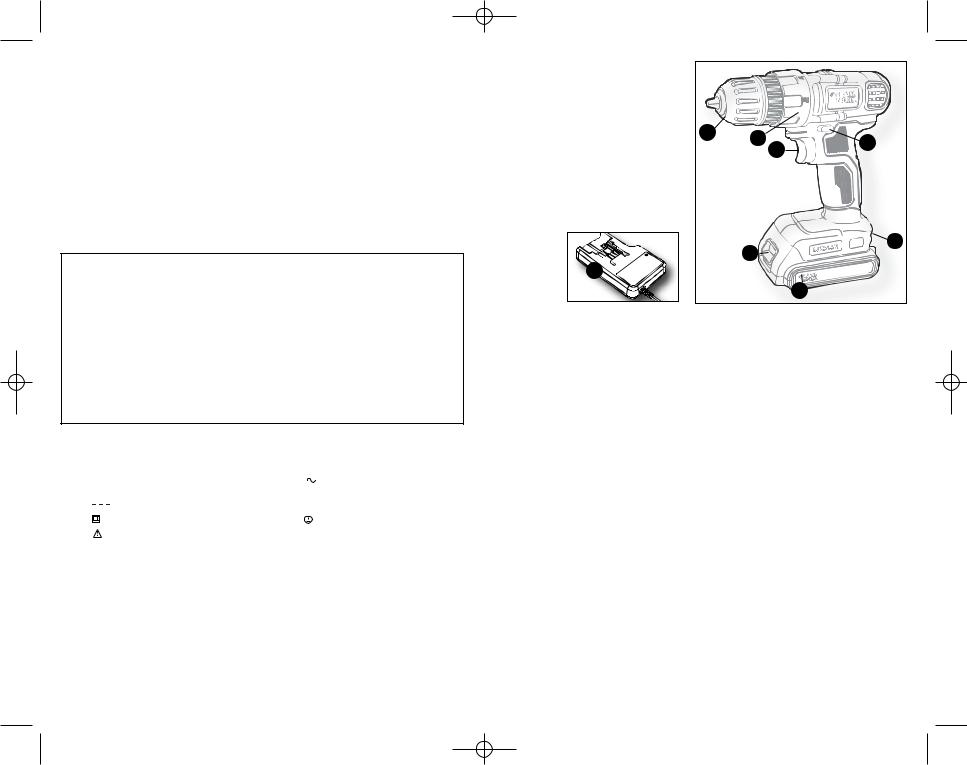
90565379 LDX116 LDX120.qxd:??????-00 BDL500 laser 6/3/10 1:43 PM Page 4
Your risk from these exposures varies, depending on how often you do this type of work. To reduce your exposure to these chemicals: work in a well ventilated area, and work with approved safety equipment, such as those dust masks that are specially designed to filter out microscopic particles.
•Avoid prolonged contact with dust from power sanding, sawing, grinding, drilling, and other construction activities. Wear protective clothing and wash exposed areas with soap and water. Allowing dust to get into your mouth, eyes, or lay on the skin may promote absorption of harmful chemicals.
 WARNING: Use of this tool can generate and/or disperse dust, which may cause serious and permanent respiratory or other injury. Always use NIOSH/OSHA approved respiratory protection appropriate for the dust exposure. Direct particles away from face and body.
WARNING: Use of this tool can generate and/or disperse dust, which may cause serious and permanent respiratory or other injury. Always use NIOSH/OSHA approved respiratory protection appropriate for the dust exposure. Direct particles away from face and body.
 WARNING: ALWAYS use safety glasses. Everyday eye glasses are NOT safety glasses. Also use face or dust mask if cutting operation is dusty.
WARNING: ALWAYS use safety glasses. Everyday eye glasses are NOT safety glasses. Also use face or dust mask if cutting operation is dusty.
ALWAYS WEAR CERTIFIED SAFETY EQUIPMENT:
•ANSI Z87.1 eye protection (CAN/CSA Z94.3)
•ANSI S12.6 (S3.19) hearing protection
•NIOSH/OSHA/MSHA respiratory protection
SAFETY GUIDELINES - DEFINITIONS
It is important for you to read and understand this manual.
The information it contains relates to protecting YOUR SAFETY and PREVENTING PROBLEMS. The symbols below are used to help you recognize this information.
 DANGER: Indicates an imminently hazardous situation which, if not avoided, will result in death or serious injury.
DANGER: Indicates an imminently hazardous situation which, if not avoided, will result in death or serious injury.
 WARNING: Indicates a potentially hazardous situation which, if not avoided, could result in death or serious injury.
WARNING: Indicates a potentially hazardous situation which, if not avoided, could result in death or serious injury.
 CAUTION: Indicates a potentially hazardous situation which, if not avoided, may result in minor or moderate injury.
CAUTION: Indicates a potentially hazardous situation which, if not avoided, may result in minor or moderate injury.
CAUTION: Used without the safety alert symbol indicates a potentially hazardous situation which, if not avoided, may result in property damage.
The label on your tool may include the following symbols. |
amperes |
||||
V .......................... |
volts |
A.......................... |
|||
Hz ........................ |
hertz |
W ........................ |
watts |
||
min ........................ |
minutes |
|
...................... |
alternating |
|
|
|
|
no |
current |
|
|
|
direct current |
no load speed |
||
|
|
||||
|
.......................... |
Class II Construction |
|
........................ |
earthing terminal |
|
|
|
|
||
|
........................ |
safety alert symbol |
...................../min |
revolutions or |
|
|
|
|
|
|
reciprocations |
|
|
|
|
|
per minute |
4
FUNCTIONAL DESCRIPTION
1.Variable speed switch
2.Forward/reverse button
3.Torque Adjustment Collar
4.Keyless Chuck
5.Battery
6.Battery release button
7.Charger
8.Screwdriver bit holder
7 |
4 |
3 |
|
2 |
|
1 |
||
|
|
||
|
|
|
|
|
6 |
|
8 |
|
|
|
|
|
|
|
5 |
IMPORTANT SAFETY INSTRUCTIONS FOR BATTERY CHARGERS
SAVE THESE INSTRUCTIONS: This manual contains important safety instructions for battery chargers.
•Before using charger, read all instructions and cautionary markings on charger, battery pack, and product using battery pack.
 WARNING: Shock hazard. Do not allow any liquid to get inside charger.
WARNING: Shock hazard. Do not allow any liquid to get inside charger.
 CAUTION: Burn hazard. To reduce the risk of injury, charge only designated Black & Decker batteries. Other types of batteries may burst causing personal injury and damage.
CAUTION: Burn hazard. To reduce the risk of injury, charge only designated Black & Decker batteries. Other types of batteries may burst causing personal injury and damage.
 CAUTION: Under certain conditions, with the charger plugged in to the power supply, the charger can be shorted by foreign material. Foreign materials of a conductive nature such as, but not limited to, steel wool, aluminum foil, or any buildup of metallic particles should be kept away from charger cavities. Always unplug the charger from the power supply when there is no battery pack in the cavity. Unplug charger before attempting to clean.
CAUTION: Under certain conditions, with the charger plugged in to the power supply, the charger can be shorted by foreign material. Foreign materials of a conductive nature such as, but not limited to, steel wool, aluminum foil, or any buildup of metallic particles should be kept away from charger cavities. Always unplug the charger from the power supply when there is no battery pack in the cavity. Unplug charger before attempting to clean.
•DO NOT attempt to charge the battery pack with any chargers other than the ones in this manual. The charger and battery pack are specifically designed to work together.
•These chargers are not intended for any uses other than charging designated
Black & Decker rechargeable batteries. Any other uses may result in risk of fire, electric shock or electrocution.
•Do not expose charger to rain or snow.
•Pull by plug rather than cord when disconnecting charger. This will reduce risk of damage to electric plug and cord.
•Make sure that cord is located so that it will not be stepped on, tripped over, or otherwise subjected to damage or stress.
•Do not use an extension cord unless it is absolutely necessary. Use of improper extension cord could result in risk of fire, electric shock, or electrocution.
•An extension cord must have adequate wire size (AWG or American Wire Gauge) for safety. The smaller the gauge number of the wire, the greater the capacity of the cable, that is 16 gauge has more capacity than 18 gauge. When using more than one extension to make up the total length, be sure each individual extension contains at least the minimum wire size.
5
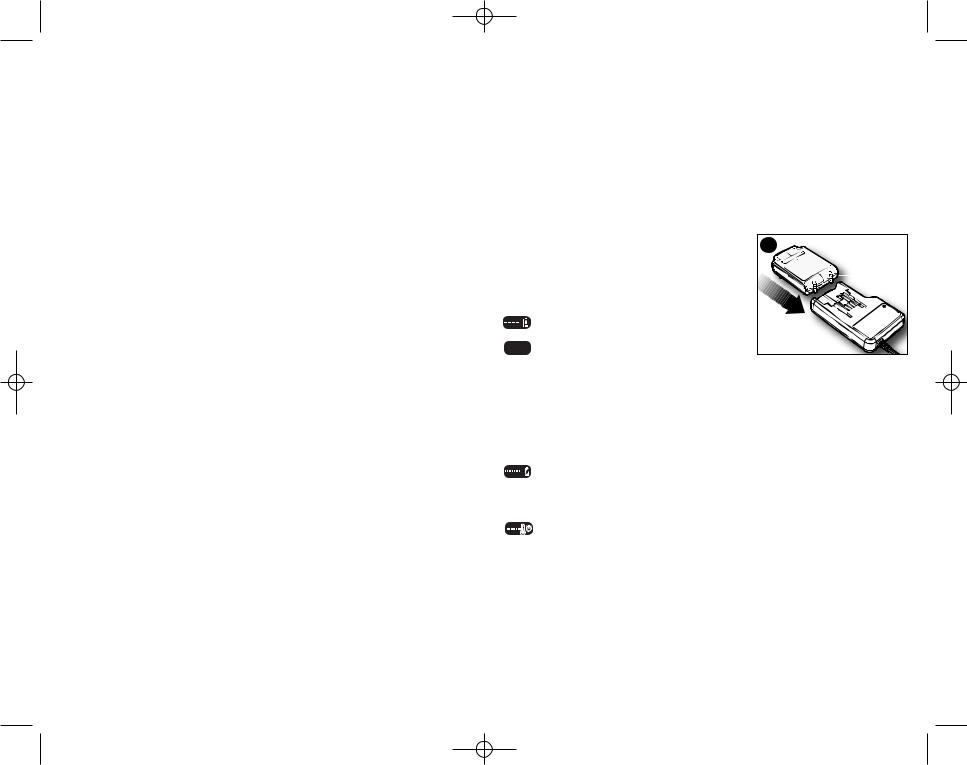
90565379 LDX116 LDX120.qxd:??????-00 BDL500 laser 6/3/10 1:43 PM Page 6
|
Recommended Minimum Wire Size for Extension Cords |
|||||
Total Length of Cord |
|
|
|
|
|
|
25 ft. |
50 ft. |
75 ft. |
100 ft. |
125 ft. |
150 ft. |
175 ft. |
7.6 m |
15.2 m |
22.9 m |
30.5 m |
38.1 m |
45.7 m |
53.3 m |
Wire Size AWG |
|
|
|
|
|
|
18 |
18 |
16 |
16 |
14 |
14 |
12 |
•Do not place any object on top of charger or place the charger on a soft surface that might block the ventilation slots and result in excessive internal heat. Place the charger in a position away from any heat source. The charger is ventilated through slots in the top and the bottom of the housing.
•Do not mount charger on wall or permanently affix charger to any surface. The charger is intended to use on a flat, stable surface (i.e., table top, bench top).
•Do not operate charger with damaged cord or plug — have them replaced immediately.
•Do not operate charger if it has received a sharp blow, been dropped, or otherwise damaged in any way. Take it to an authorized service center.
•Do not disassemble charger; take it to an authorized service center when service or repair is required. Incorrect reassembly may result in a risk of electric shock, electrocution or fire.
•Disconnect the charger from the outlet before attempting any cleaning. This will reduce the risk of electric shock. Removing the battery pack will not reduce this risk.
•NEVER attempt to connect 2 chargers together.
•The charger is designed to operate on standard household electrical power (120 Volts). Do not attempt to use it on any other voltage.
SAVE THESE INSTRUCTIONS
IMPORTANT SAFETY INSTRUCTION FOR BATTERY PACKS
 WARNING: For safe operation, read this manual and manuals originally supplied with tool before using the charger.
WARNING: For safe operation, read this manual and manuals originally supplied with tool before using the charger.
The battery pack is not fully charged out of the carton. Before using the battery pack and charger, read the safety instructions below. Then follow charging procedures outlined.
READ ALL INSTRUCTIONS
•Do not incinerate the battery pack even if it is severely damaged or is completely worn out. The battery pack can explode in a fire. Toxic fumes and materials are created when battery packs are burned.
•Do not charge or use battery in explosive atmospheres, such as in the presence of flammable liquids, gases or dust. Inserting or removing the battery from the charger may ignite the dust or fumes.
•If battery contents come into contact with the skin, immediately wash area with mild soap and water. If battery liquid gets into the eye, rinse water over the open eye for 15 minutes or until irritation ceases. If medical attention is needed, the battery electrolyte for Li-ion batteries is composed of a mixture of liquid organic carbonates and lithium salts.
•Contents of opened battery cells may cause respiratory irritation. Provide fresh air. If symptoms persist, seek medical attention.
 WARNING: Burn hazard. Battery liquid may be flammable if exposed to spark or flame.
WARNING: Burn hazard. Battery liquid may be flammable if exposed to spark or flame.
•Charge the battery packs only in Black & Decker chargers.
•DO NOT splash or immerse in water or other liquids. This may cause premature cell failure.
•Do not store or use the tool and battery pack in locations where the temperature may reach or exceed 105°F (40˚C) (such as outside sheds or metal buildings in summer).
 WARNING: Never attempt to open the battery pack for any reason. If battery pack case is cracked or damaged, do not insert into charger. Do not crush, drop or damage battery pack. Do not use a battery pack or charger that has received a sharp blow, been dropped, run over or damaged in any way (i.e., pierced with a nail, hit with a hammer, stepped on). Damaged battery packs should be returned to service center for recycling.
WARNING: Never attempt to open the battery pack for any reason. If battery pack case is cracked or damaged, do not insert into charger. Do not crush, drop or damage battery pack. Do not use a battery pack or charger that has received a sharp blow, been dropped, run over or damaged in any way (i.e., pierced with a nail, hit with a hammer, stepped on). Damaged battery packs should be returned to service center for recycling.
6
 WARNING: Fire hazard. Do not store or carry battery so that metal objects can contact exposed battery terminals. For example, do not place battery in aprons, pockets, tool boxes, product kit boxes, drawers, etc., with loose nails, screws, keys, etc.
WARNING: Fire hazard. Do not store or carry battery so that metal objects can contact exposed battery terminals. For example, do not place battery in aprons, pockets, tool boxes, product kit boxes, drawers, etc., with loose nails, screws, keys, etc.
Transporting batteries can possibly cause fires if the battery terminals inadvertently come in contact with conductive materials such as keys, coins, hand tools and the like. The US Department of Transportation Hazardous Material Regulations (HMR) actually prohibit transporting batteries in commerce or on airplanes (i.e., packed in suitcases and carry-on luggage) UNLESS they are properly protected from short circuits. So when transporting individual batteries, make sure that the battery terminals are protected and well insulated from materials that could contact them and cause a short circuit. NOTE: LI-ION batteries should not be put in checked baggage.
STORAGE RECOMMENDATIONS
1.The best storage place is one that is cool and dry away from direct sunlight and excess heat or cold.
2.Long storage will not harm the battery pack or charger.
CHARGING PROCEDURE
Black & Decker chargers are designed to charge Black & Decker battery packs in 5-8 hours depending on the pack being charged.
1.Plug the charger into an appropriate outlet before inserting the battery pack.
2.Insert the battery pack into the charger as shown in figure A.
3.The green LED will flash indicating that the
 battery is being charged.
battery is being charged.
4. The completion of charge is indicated by the 
 green LED remaining on continuously. The pack is fully charged and may be used at this time or
green LED remaining on continuously. The pack is fully charged and may be used at this time or
left on the charger.
A |
Recharge discharged batteries as soon as possible after use or battery life may be greatly diminished. For longest battery life, do not discharge batteries fully. It is recommended that the batteries be recharged after each use.
CHARGER DIAGNOSTICS
This charger is designed to detect certain problems that can arise with the battery packs or the power source. Problems are indicated by one LED flashing in different patterns.
BAD BATTERY
The charger can detect a weak or damaged battery. The red LED flashes in the pattern indicated on the label. If you see this bad battery blink pattern, do not continue to charge the battery. Return it to a service center or a collection site for recycling.
HOT/COLD PACK DELAY
When the charger detects a battery that is excessively hot or excessively cold, it automatically starts a Hot/Cold Pack Delay, suspending charging until the battery has normalized. After this happens, the charger automatically switches to the Pack Charging mode. This feature ensures maximum battery life. The red LED flashes in the pattern indicated on the label.
LEAVING THE BATTERY IN THE CHARGER
The charger and battery pack can be left connected with the green LED glowing indefinitely. The charger will keep the battery pack fresh and fully charged.
IMPORTANT CHARGING NOTES
1.Longest life and best performance can be obtained if the battery pack is charged when the air temperature is between 65°F and 75°F (18°- 24°C). DO NOT charge the battery pack in an air temperature below +40°F (+4.5°C), or above +105°F (+40.5°C). This is important and will prevent serious damage to the battery pack.
2.The charger and battery pack may become warm to touch while charging. This is a normal condition, and does not indicate a problem. To facilitate the cooling of the battery pack after use, avoid placing the charger or battery pack in a warm environment such as in a metal shed, or an uninsulated trailer.
7
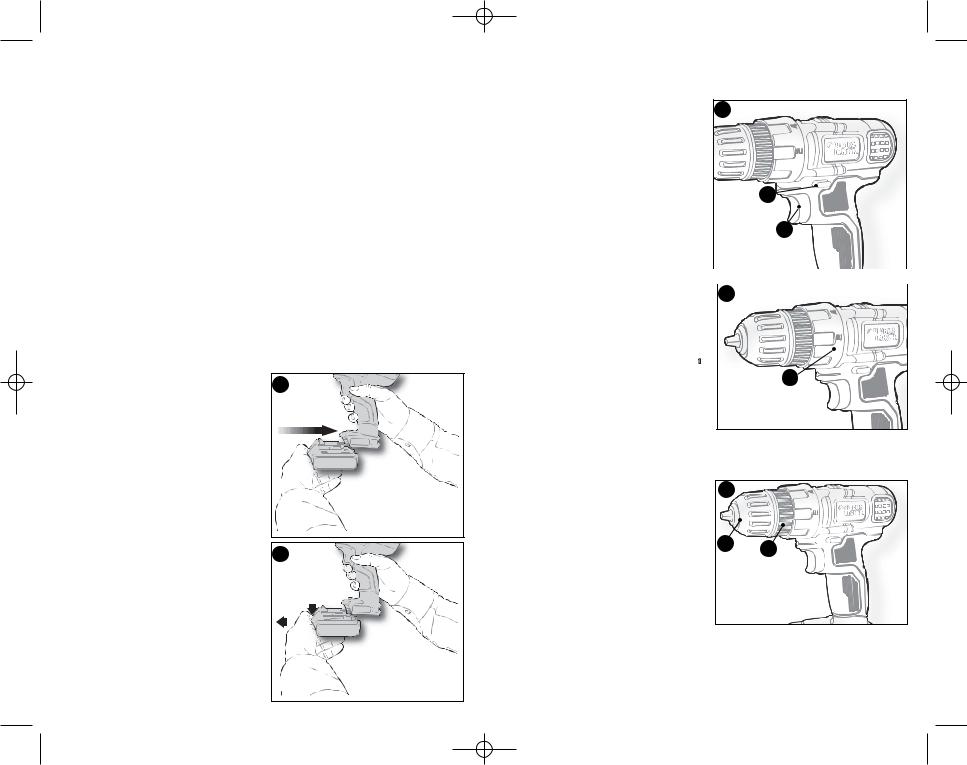
90565379 LDX116 LDX120.qxd:??????-00 BDL500 laser 6/3/10 1:43 PM Page 8
3.If the battery pack does not charge properly:
a.Check current at receptacle by plugging in a lamp or other appliance
b.Check to see if receptacle is connected to a light switch which turns power off when you turn out the lights.
c.Move charger and battery pack to a location where the surrounding air temperature is approximately 65°F - 75°F (18°- 24°C).
d.If charging problems persist, take the tool, battery pack and charger to your local service center.
4.The battery pack should be recharged when it fails to produce sufficient power on jobs which were easily done previously. DO NOT CONTINUE to use under these conditions. Follow the charging procedure. You may also charge a partially used pack whenever you desire with no adverse affect on the battery pack.
5.Foreign materials of a conductive nature such as, but not limited to, steel wool, aluminum foil, or any buildup of metallic particles should be kept away from charger cavities. Always unplug the charger from the power supply when there is no battery pack in the cavity. Unplug charger before attempting to clean.
6.Do not freeze or immerse charger in water or any other liquid.
 WARNING: Shock hazard. Do not allow any liquid to get inside charger. Never attempt to open the battery pack for any reason. If the plastic housing of the battery pack breaks or cracks, return to a service center for recycling.
WARNING: Shock hazard. Do not allow any liquid to get inside charger. Never attempt to open the battery pack for any reason. If the plastic housing of the battery pack breaks or cracks, return to a service center for recycling.
SAFETY WARNINGS AND INSTRUCTIONS: DRILLS
1.Hold drill firmly with one hand on the grip and the other hand on the bottom of the battery pack.
2.When attaching accessories in the drill chuck, hand tighten the keyless chuck firmly.
 WARNING: Drill may stall (if overloaded or improperly used) causing a twist. Always expect the stall. Grip the drill firmly with both hands to control the twisting action and prevent loss of control which could cause personal injury. If a stall does occur, release the trigger immediately and determine the reason for the stall before re-starting.
WARNING: Drill may stall (if overloaded or improperly used) causing a twist. Always expect the stall. Grip the drill firmly with both hands to control the twisting action and prevent loss of control which could cause personal injury. If a stall does occur, release the trigger immediately and determine the reason for the stall before re-starting.
INSTALLING AND REMOVING THE |
B |
BATTERY PACK FROM THE TOOL |
 WARNING: Make certain the lock-off button is engaged to prevent switch actuation before removing or installing battery.
WARNING: Make certain the lock-off button is engaged to prevent switch actuation before removing or installing battery.
TO INSTALL BATTERY PACK: Insert battery pack into tool until an audible click is heard (figure B).
TO REMOVE BATTERY PACK: Depress the |
|
battery release button as shown in figure C |
C |
and pull battery pack out of tool. |
8
OPERATING INSTRUCTIONS
TRIGGER SWITCH & REVERSING BUTTON (FIGURE D)
•The drill is turned ON and OFF by pulling
and releasing the trigger switch (1). The |
D |
|
|
farther the trigger is depressed, the higher |
|
|
|
the speed of the drill. |
|
|
|
• A forward/reverse control button (2) |
|
|
|
determines the direction of the tool and |
|
|
|
also serves as a lock off button. |
|
|
|
• To select forward rotation, release the |
|
|
|
trigger switch and depress the |
|
|
|
forward/reverse control button to the left. |
2 |
|
|
• To select reverse, depress the |
|
|
|
forward/reverse control button the opposite |
|
|
|
direction. |
1 |
|
|
NOTE: The center position of the control |
|
||
button locks the tool in the off position. |
|
|
|
When changing the position of the control |
|
|
|
button, be sure the trigger is released. |
|
|
|
TORQUE CONTROL (FIGURE E) |
|
|
|
This tool is fitted with a torque adjustment |
E |
|
|
collar (3) to select the operating mode and to |
|
||
set the torque for tightening screws. Large |
|
|
|
screws and hard workpiece materials require a |
|
|
|
higher torque setting than small screws and |
|
|
|
soft workpiece materials. |
|
|
|
• For drilling in wood, metal and plastics, set |
|
|
|
the collar to the drilling position symbol |
|
|
|
• For screwdriving, set the collar to the |
3 |
|
|
desired setting. If you do not yet know the |
|
|
|
appropriate setting, proceed as follows: |
|
|
|
•Set the collar to the lowest torque setting.
•Tighten the first screw.
•If the clutch ratchets before the desired
result is achieved, increase the collar setting and continue tightening the screw. Repeat until you reach the correct setting. Use this setting for the remaining screws.
KEYLESS CHUCK (FIGURE F)
 WARNING: Make certain the lock-off
WARNING: Make certain the lock-off
button is engaged to prevent switch actuation F before installing or removing accessories.
To insert a drill bit or other accessory:
1. Grasp the rear half of the chuck (4) with |
|
|
one hand and use your other hand to |
4a |
|
rotate the front half (4a) in the |
4 |
|
counterclockwise direction, as viewed from |
|
|
the chuck end. |
|
|
2.Insert the bit or other accessory fully into the chuck, and tighten securely by holding the rear half of the chuck and rotating the front portion in the clockwise direction as
viewed from the chuck end.  WARNING: Do not attempt to tighten drill
WARNING: Do not attempt to tighten drill
bits (or any other accessory) by gripping the front part of the chuck and turning the tool on. Damage to the chuck and personal injury may occur when changing accessories.
SCREW DRIVING
For driving fasteners, the reversing button should be pushed to the left. Use reverse (button pushed to the right) for removing fasteners. When moving from forward to reverse, or vice versa, always release the trigger switch first.
9
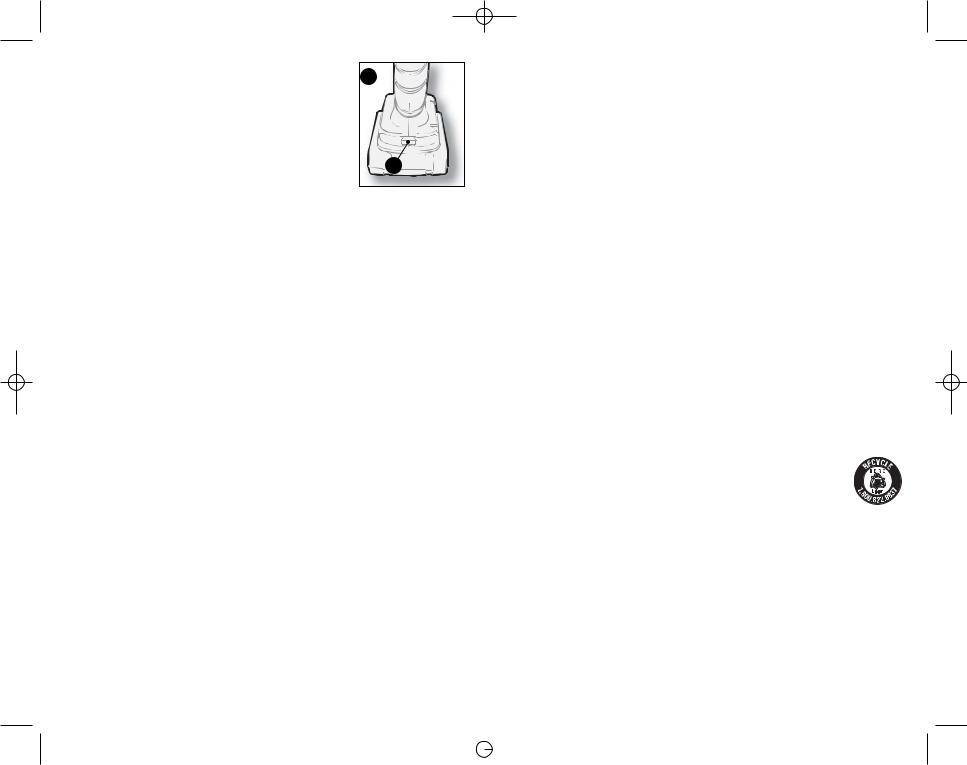
90565379 LDX116 LDX120.qxd:??????-00 BDL500 laser 6/3/10 1:43 PM Page 10
ON BOARD BIT STORAGE
A bit storage slot (8)is built-in to the area just above the battery G pack.
 8
8
DRILLING
•Use sharp drill bits only.
•Support and secure work properly, as instructed in the Safety Instructions.
•Use appropriate and required safety equipment, as instructed in the Safety Instructions.
•Secure and maintain work area, as instructed in the Safety Instructions.
•Run the drill very slowly, using light pressure, until the hole is started enough to keep the drill bit from slipping out of it.
•Apply pressure in a straight line with the bit. Use enough pressure to keep the bit biting but not so much as to stall the motor or deflect the bit.
•Hold the drill firmly with two hands to control its twisting action.
•DO NOT CLICK THE TRIGGER OF A STALLED DRILL OFF AND ON IN AN ATTEMPT TO START IT. DAMAGE TO THE DRILL CAN RESULT.
•Minimize stalling on breakthrough by reducing pressure and slowly drilling through the last part of the hole.
•Keep the motor running while pulling the bit out of a drilled hole. This will help reduce jamming.
•Make sure switch turns drill on and off.
DRILLING IN WOOD
Holes in wood can be made with the same twist drill bits used for metal or with spade bits. These bits should be sharp and should be pulled out frequently when drilling to clear chips from the flutes.
DRILLING IN METAL
Use a cutting lubricant when drilling metals. The exceptions are cast iron and brass which should be drilled dry. The cutting lubricants that work best are sulfurized cutting oil or lard oil.
DRILLING IN MASONRY
Use carbide tipped masonry bits. Refer to Drilling section. Keep even force on the drill but not so much that you crack the brittle material. A smooth, even flow of dust indicates the proper drilling rate.
MAINTENANCE
Use only mild soap and damp cloth to clean the tool. Never let any liquid get inside the tool; never immerse any part of the tool into a liquid.
IMPORTANT: To assure product SAFETY and RELIABILITY, repairs, maintenance and adjustment (other than those listed in this manual) should be performed by authorized service centers or other qualified service personnel, always using identical replacement parts.
TROUBLESHOOTING
Problem |
PossibleCause |
PossibleSolution |
• Unit will not start. |
• Battery pack not installed properly. |
• Check battery pack |
|
• Battery pack not charged. |
installation. |
|
• Check battery pack charging |
|
• Battery pack will not charge. |
• Battery pack not inserted into charger. |
requirements. |
• Insert battery pack into |
||
|
|
charger until green LED |
|
• Charger not plugged in. |
appears. |
|
• Plug charger into a working |
|
|
|
outlet. Refer to “Important |
|
|
Charging Notes” for more |
|
• Surrounding air temperature |
details. |
|
• Move charger and battery |
|
|
too hot or too cold. |
pack to a surrounding air |
|
|
temperature of above 40 |
|
|
degrees F (4.5°C) or below |
|
|
105 degrees F (+40.5°C). |
• Unit shuts off abruptly. |
• Battery pack has reached its |
•Allow battery pack to cool |
|
maximum thermal limit. |
down. |
|
• Out of charge. ( To |
• Place on charger and |
|
maximizethelifeofthe |
allow to charge. |
|
batterypackitisdesigned |
|
|
toshutoffabruptlywhen |
|
|
thechargeisdepleted.) |
|
For assistance with your product, visit our website www.blackanddecker.com for the location of the service center nearest you or call the BLACK & DECKER help line at
1-800-544-6986.
ACCESSORIES
Recommended accessories for use with your tool are available from your local dealer or authorized service center. If you need assistance regarding accessories, please call:
1-800-544-6986.
 WARNING: The use of any accessory not recommended for use with this tool could be hazardous.
WARNING: The use of any accessory not recommended for use with this tool could be hazardous.
The RBRC™ Seal
The RBRC™ (Rechargeable Battery Recycling Corporation) Seal on the lithium-ion battery (or battery pack) indicates that the costs to recycle the battery (or battery pack) at the end of its useful life have already been paid by Black & Decker. In some areas, it is illegal to place spent lithium-ion batteries
in the trash or municipal solid waste stream and the RBRC program provides an environmentally conscious alternative.
RBRC in cooperation with Black & Decker and other battery users, has established programs in the United States and Canada to facilitate the collection of spent lithium-ion batteries. Help protect our environment and conserve natural resources by returning the tool to an authorized Black & Decker service center for recycling. You may also contact your local recycling center for information on where to drop off the spent battery, or cal
1-800-8-BATTERY.
10 |
11 |
||
|
|
|
|
|
|
|
|
|
|
|
|
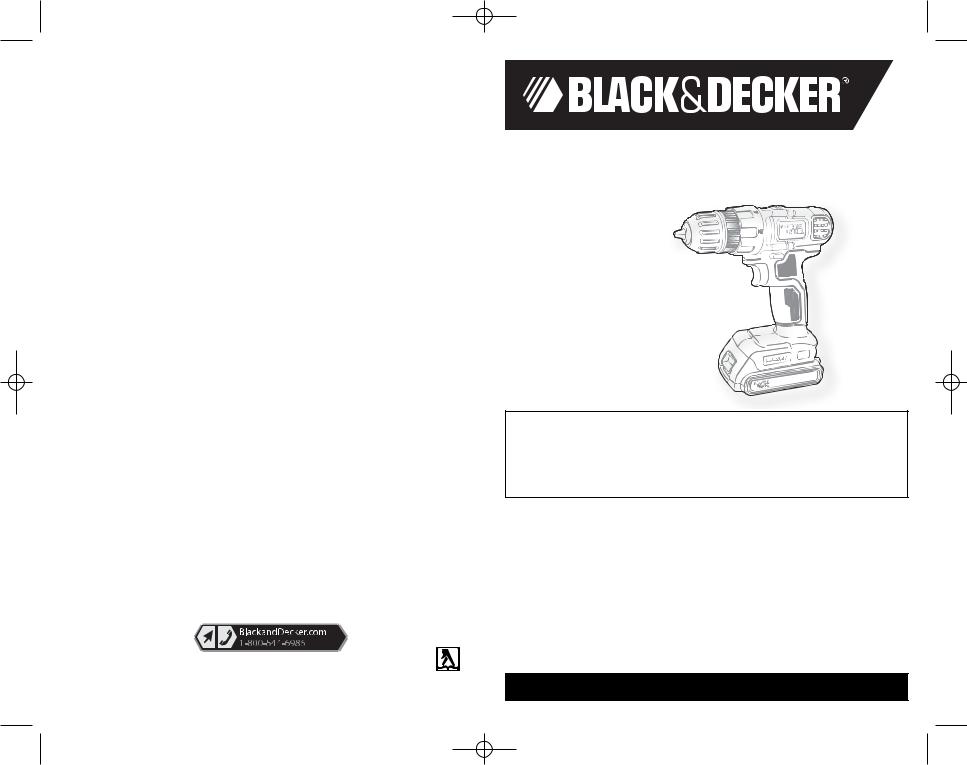
90565379 LDX116 LDX120.qxd:??????-00 BDL500 laser 6/3/10 1:43 PM Page 12
This Class B digital apparatus complies with Canadian ICES-003.
This device complies with part 15 of the FCC rules. Operation is subject to the following two conditions: (1) This device may not cause harmful interference, and (2) this device must accept any interference received, including interference that may cause undesired operation.
NOTE: This equipment has been tested and found to comply with the limits for a Class B digital device, pursuant to Part 15 of the FCC Rules. These limits are designed to provide reasonable protection against harmful interference in a residential installation. This equipment generates, uses and can radiate radio frequency energy and, if not installed and used in accordance with the instructions, may cause harmful interference to radio communications. However, there is no guarantee that interference will not occur in a particular installation.
If this equipment does cause harmful interference to radio or television reception, which can be determined by turning the equipment off and on, the user is encouraged to try to correct the interference by one or more of the following measures:
•Reorient or relocate the receiving antenna.
•Increase the separation between the equipment and receiver.
•Connect the equipment into an outlet on a circuit different from that to which the receiver is connected.
•Consult the dealer or an experienced radio/TV technician for help.
Changes or modifications to this unit not expressly approved by the party responsible for compliance could void the user's authority to operate the equipment. This Class B digital apparatus complies with Canadian ICES-003.
SERVICE INFORMATION
All Black & Decker Service Centers are staffed with trained personnel to provide customers with efficient and reliable power tool service. Whether you need technical advice, repair, or genuine factory replacement parts, contact the Black & Decker location nearest you. To find your local service location, refer to the yellow page directory under "Tools—Electric" or call: 1-800-544-6986 or visit www.blackanddecker.com
FULL TWO-YEAR HOME USE WARRANTY
Black & Decker (U.S.) Inc. warrants this product for two years against any defects in material or workmanship. The defective product will be replaced or repaired at no charge in either of two ways.
The first, which will result in exchanges only, is to return the product to the retailer from whom it was purchased (provided that the store is a participating retailer). Returns should be made within the time period of the retailerʼs policy for exchanges (usually 30 to 90 days after the sale). Proof of purchase may be required. Please check with the retailer for their specific return policy regarding returns that are beyond the time set for exchanges.
The second option is to take or send the product (prepaid) to a Black & Decker owned or authorized Service Center for repair or replacement at our option. Proof of purchase may be required.Black & Decker owned and authorized Service Centers are listed under "Tools-Electric" in the yellow pages of the phone directory.
This warranty does not apply to accessories. This warranty gives you specific legal rights and you may have other rights which vary from state to state or province to province. Should you have any questions, contact the manager of your nearest Black & Decker Service Center. This product is not intended for commercial use.
FREE WARNING LABEL REPLACEMENT: If your warning labels become illegible or are missing, call 1-800-544-6986 for a free replacement.
LATIN AMERICA: This warranty does not apply to products sold in Latin America. For products sold in Latin America, check country specific warranty information contained in the packaging, call the local company or see the website for warranty information.
Imported by |
See ‘Tools- |
Black & Decker (U.S.) Inc., |
Electric’ |
701 E. Joppa Rd. |
– Yellow Pages – |
Towson, MD 21286 U.S.A. |
for Service & |
|
Sales |
|
12 |
MODE DʼEMPLOI DE LA PERCEUSE SANS FIL
DE 16V MAX*, 20V MAX*
N° de catalogue
LDX116 (16V MAX*)
LDX120 (20V MAX*)
*La tension initiale maximale du bloc-piles (mesurée sans charge de travail) est de 16 volts. La tension nominale, mesurée avec une charge de travail, est de 14.4 volts.
*La tension initiale maximale du bloc-piles (mesurée sans charge de travail) est de 20 volts. La tension nominale, mesurée avec une charge de travail, est de 18 volts.
Merci d’avoir choisi Black & Decker! Consulter le site Web www.BlackandDecker.com/NewOwner pour enregistrer votre nouveau produit.
ÀLIRE AVANT DE RETOURNER CE PRODUIT POUR QUELQUE RAISON QUE CE SOIT :
Si des questions ou des problèmes surgissent après l’achat d’un produit Black & Decker, consulter le site Web
HTTP://WWW.BLACKANDDECKER.COM/INSTANTANSWERS pour obtenir des réponses instantanément 24 heures par jour.
Si la réponse est introuvable ou en l’absence d’accès à Internet, composer le 1-800-544-6986 de 8 h à 17 h HNE, du lundi au vendredi, pour parler avec un agent. Prière d’avoir le numéro de catalogue sous la main lors de l’appel.
CONSERVER CE MANUEL POUR UN USAGE ULTÉRIEUR.
13
